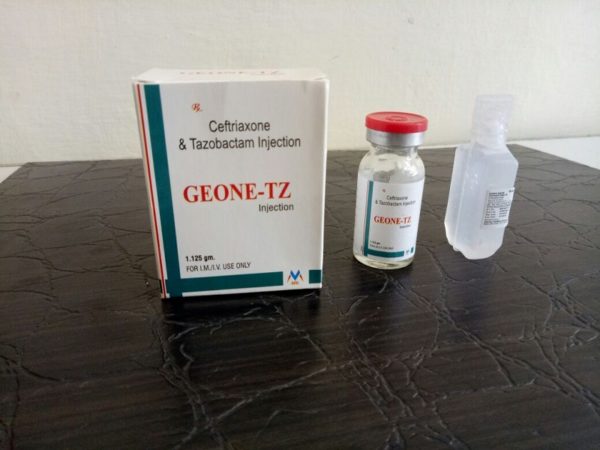GEONE-TZ
COMPOSITION : CEFTRIAXONE SODIUM 1000 MG + TAZOBACTUM 125 MG
- Reviews (0)
- Indications
- Description
Be the first to review “GEONE-TZ”
Lower respiratory tract infections and community-acquired pneumonia. Skin and skin structure infections. Urinary tract infections. Uncomplicated gonorrhea. Pelvic inflammatory disease. Bacterial septicemia. Bone and joint infections. Intra-abdominal infections. Bacterial meningitis. Pre-operative prophylaxis of infections associated with surgery.
Ceftriaxone is a broad spectrum antibiotic which interferes with the biosynthesis of the peptidoglycan component of the bacterial cell wall by binding to and inactivating penicllin-binding proteins (PBPs).
Tazobactam is a penicillanic acid sulfone derivative with lactamase inhibitory properties. It enhances the activity of lactam antibacterials against lactamase-producing bacteria.
RATIONALE OF COMBINATION
Product Description
The combination of Ceftriaxone and Tazbactam provides a solution for treatment of the bacterial infections caused by beta-lactam resistant pathogens. Ceftriaxone has a broad spectrum of antibacterial activity is beta-lactamase stable and exhibits excellent activity against Streptococcus pneumoniae, methicillin-susceptible staphylococci, Haemophilus influenzae, Moraxella catarrhalis and Neisseria spp which are the most common cause of community acquired and hospital acquired infections.
Ceftriaxone is more potent and hence less protection from a beta- lactamases inhibitor is required for the antibiotic and fewer drug molecules are needed for optimal activity.
Tazobactam (sodium), a triazolylmethyl penicillanic acid sulfone, is a new beta lactamase inhibitor with a range of activity that includes extended spectrum plasmid mediated beta.
PHARMACOLOGY
PHARMACOKINETICS
Ceftriaxone
Ceftriaxone is completely absorbed following IM administration with mean maximum plasma concentration occurring between 2-3 hours post dose. Ceftriaxone achieves high concentrations in urine. 33% to 67% of ceftriaxone was excreted as unchanged drug and the remainder is excreted in bile and faeces. Elimination half life is 8.7 hours. Ceftriaxone is 98% bound to plasma proteins and Ceftriaxone crosses the blood brain barrier.
Tazobactam
Tazobactam is metabolized to a single metabolite that lacks pharmacological and antibacterial activities. Tazobactam and its metabolite are eliminated primarily by renal excretion with 80 % of the ministered dose excreted as unchanged drug and the remainder as a single metabolite. Tazobactam is also secreted into the bile. Tazobactam is approximately 30% bound to plasma proteins. Protein binding of the tazobactam metabolite is negligible. Tazobactam is widely distributed into tissues and body fluids including intestinal mucosa, gall bladder, lung, female reproductive tissues, interstitial fluid and bile.
ADVERSE EFFECTS
Superinfection; anaphylaxis; diarrhoea; local reactions; blood dyscrasias; rash, fever, pruritus; elevated transaminases and alkaline phosphatase. GI effects; pseudomembranous colitis; hematologic effects; hypersensitivity reactions; CNS disturbances; hypertension; chest pain; edema; moniliasis; rhinitis; dyspnea; hypotension; ileus; syncope; local Inj site reactions; rigors.
Potentially Fatal
Pseudomembranous colitis; nephrotoxicity.
CONTRAINDICATIONS
Hypersensitivity to cephalosporin’s and beta lactamase inhibitors.
DRUG INTERACTIONS
Ceftriaxone (Na) is known to interact with other drugs like probenecid, aminoglycosides, vecuronium, methotrexate, oral anticoagulants, heparin and alcohol.






Reviews
There are no reviews yet.